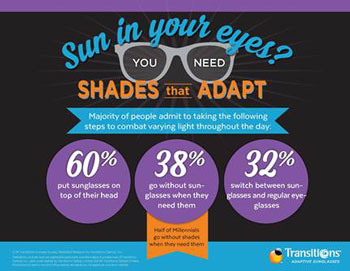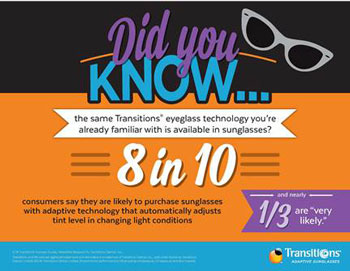PINELLAS PARK, Fla.—Research from the inaugural Transitions Adaptive Sunglasses Selection Survey finds that nearly nine in 10 consumers (87 percent) take steps that disrupt sun protection in order to combat varying light throughout the day. Sixty percent of consumers saidthey put sunglasses on top of their head to compensate for changing light conditions, while more than one-third (38 percent) admit to going without sunglasses when they need them or switching between sunglasses and regular eyeglasses (32 percent).
In particular, Millennials are most likely to simply go without sunglasses to combat the change in weather conditions, leaving their eyes exposed to harmful UV rays. Half of Millennials surveyed said they go without shades even when they need them, compared to 38 percent of Gen Xers and 28 percent of Baby Boomers.

“Outdoor light and weather are constantly changing, and if our sunglasses don’t react it can become very disruptive—to the point where a large portion of people, as we learned from the data, go without the proper UV and light protection when it’s most needed,” said Catherine Rauscher, global director, for lenscaster partners, Transitions Optical. “Transitions adaptive sun lenses use the same leading photochromic technology as our prescription eyeglass lenses. They react automatically to changing light and adjust the level of tint in lenses to protect eyes and provide visual clarity and comfort. Consumers should expect the same quality of choice and automation in their sunglasses that exists in other products they use every day.”
Technology Is in Style
The survey reveals technology innovation is a key consideration influencing consumer sunglass selection. Seventy percent of survey respondents said it is an important aspect in their purchase decision. Technology is an even more important and valued aspect of sunglasses for prescription wearers. One in five of Rx wearers (22 percent) said it is “extremely important” when deciding which pair of sunglasses to purchase.
The optical industry has seen significant advancements in lens technology, materials and manufacturing processes within recent years. Lenses are thinner and offer higher levels of protection and vision correction. High-tech features like blue light protection, polarization, color optimization and photochromics continue to grow in popularity among consumers.
And while a majority of consumers agreed style and aesthetics is the No. 1 criterion for selecting a pair of sunglasses, the quality of vision through the lenses remains a top consideration. More than one-third of consumers (35 percent) said the optics is the most important aspect when deciding which sunglasses to purchase. Additionally, 15 percent of survey respondents said quality of optics and sharpness of vision is the feature in their sunglasses they would most like to see improved in their next pair.
More Education on Adaptive Technology Is Needed
The Transitions Adaptive Sunglasses Selection Survey finds that nine out of 10 consumers say they would value the convenience of wearing a pair of sunglasses that automatically adjusts the level of tint as sunlight changes throughout the day, and 82 percent of respondents saidthey are likely to purchase sunglasses that adjust tint level based on varying light conditions. Despite this, only 6 percent of respondents in the survey said they wear photochromic sunglasses.

“There is a significant opportunity for eyecare professionals and retailers to help educate consumers about the advantages of photochromic sunwear and the options available to them,” said Rauscher. “To complement their everyday Transitions adaptive lenses, we offer adaptive sun lenses, helmet shields and snow goggle lenses that deliver the highest visual clarity and comfort for a range of sport specific and outdoor activities. Anyone who lives an active lifestyle can benefit from sun lenses that automatically adapt to the ideal tint in all weather conditions.”
The recognition of availability of photochromic sunwear technology may also have a positive influence on purchase decisions for everyday photochromic lenses.
The majority of consumers (56 percent) said they are not aware that Transitions Optical makes both prescription and non-prescription sunglasses that start with an initial tint and turn darker in response to sunlight. Yet, 83 percent of respondents who require vision correction said they are more likely to purchase Transitions everyday prescription eyeglass lenses (clear to dark lenses) knowing that the company offers adaptive sunglasses.
One in five respondents—and an equal percentage of Millennials—said knowing that Transitions Optical offers adaptive sunglasses make them "much more likely" to purchase everyday prescription lenses.
More information about the company and Transitions adaptive sunglasses and shields, is posted at Transitions.com/sunwear.